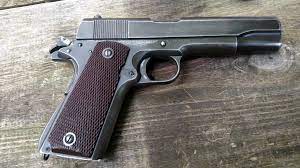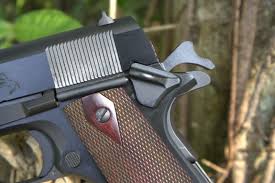Striker Fired VS Hammer Fired Pistols - A Comprehensive Comparison
- S.R. Rokhum
- Nov 1, 2024
- 5 min read
Updated: 2 days ago
Pistols are a popular choice for self-defense, sport shooting, and law enforcement. Among the many types available, striker-fired and hammer-fired options stand out. Each site offers unique characteristics, advantages, and disadvantages that can greatly affect a shooter's experience. This blog post explores the key differences between striker-fired and hammer-fired pistols, helping you make an informed choice based on your needs.

These are the two main types of ignition systems in modern semi-auto handguns. They affect trigger feel, mechanical design, safety, and user preference.
1. Basic Mechanism
Hammer-Fired
Uses a physical hammer to strike the firing pin (or the primer directly).
Can be exposed (visible from the outside) or internal (hidden).
Comes in:
Single Action (SA) — e.g., M1911
Double Action (DA/SA) — e.g., Beretta 92, SIG P226
Double Action Only (DAO) — e.g., some revolver-style pistols
Striker-Fired
No hammer. Uses a spring-loaded striker (firing pin) that's partially or fully cocked inside the slide.
Trigger completes the cocking action and releases the striker.
All internals—no external hammer.
2. Trigger Feel
Feature | Hammer-Fired | Striker-Fired |
Trigger Pull | Can be very crisp (SA) or heavy (DA) | Typically consistent, medium weight |
Reset | Shorter and more tactile (in many SA guns) | Varies by brand, usually consistent |
Learning Curve | DA/SA can be harder to master (2 pull types) | Easier to learn—one consistent pull |
3. Safety Features
Hammer-Fired:
Often have manual safeties, decockers, or firing pin blocks.
SA pistols usually have a thumb safety (like on a 1911).
DA/SA often include a decocker to safely lower the hammer.
Striker-Fired:
Usually, no manual safety (though some models offer it).
Rely on internal safeties:
Trigger safety (Glock-style)
Firing pin block
Drop safety
Note: This minimalist approach is part of their appeal, especially in duty or concealed carry use.
4. Construction & Maintenance
Aspect | Hammer-Fired | Striker-Fired |
Moving Parts | More mechanical complexity | Fewer moving parts |
Maintenance | Slightly more involved | Generally easier |
Durability | Tough, but more to clean | Known for reliability under abuse |
5. Popular Examples
Hammer-Fired | Striker-Fired |
M1911 (SA) | Glock 17 / 19 |
Beretta 92 (DA/SA) | Smith & Wesson M&P |
SIG P226 (DA/SA) | SIG P320 |
CZ 75 (DA/SA or SA) | Heckler & Koch VP9 |
HK USP (DA/SA or SA) | Springfield XD series |
6. Use Cases & Preference
Use Case | Hammer-Fired | Striker-Fired |
Traditional shooters | 👍 Love the history, tuning, feel | ❌ Too modern for some |
Modern carry | ❌ Heavier, more parts | 👍 Lightweight, fewer controls |
Competitive shooting | 👍 M1911s and CZs dominate | 👍 Also popular, especially tuned Glocks |
Military/Law Enforcement | Used extensively for decades | Now more dominant (Glock, P320, etc.) |
Summary:
Feature | Hammer-Fired | Striker-Fired |
Trigger Style | SA, DA/SA, DAO | Mostly consistent, mid-weight |
Parts | More complex | Simpler design |
Safety | More manual options | Passive/internal safeties |
Feel | Tactile, classic | Modern, consistent |
Use | Great for range, carry (trained) | Great for carry, duty, self-defense |
What is a Striker-Fired Pistol?
Striker-fired pistols use a spring-loaded striker in their firing mechanism. Pulling the trigger moves the striker forward, igniting the cartridge's primer and discharging the weapon. This design removes the need for a separate hammer, simplifying the operation and reducing moving parts.

Common models include the Glock 19, Smith & Wesson M&P, and Walther PPQ. Many gun owners appreciate their consistent trigger pulls and reliability, which are vital for accurate shooting.
Advantages of Striker-Fired Pistols
One major advantage of striker-fired pistols is their consistent trigger pull. For instance, Glock pistols generally have a consistent pull weight of around 5.5 pounds from the first round to the last. This uniformity enhances accuracy, especially in rapid-fire situations, where consistent performance is crucial.
Striker-fired designs also come with fewer moving parts, leading to less chance of mechanical failure. This simplicity means better reliability, which is essential in self-defense scenarios. For example, the lighter weight of models like the Springfield XD-S makes them more comfortable for all-day carrying.
Additionally, many striker-fired pistols have internal safety mechanisms, allowing users to skip an external safety lever. This design streamlines operation, making them easier to handle under stress.
Disadvantages of Striker-Fired Pistols
Despite their advantages, striker-fired pistols have some drawbacks. Some users find the trigger pull too light or spongy, which can lead to unintended discharges without careful handling.
Another disadvantage is the lack of an external hammer. Many shooters prefer the cocked-and-locked carry style, commonly used with hammer-fired models. The absence of this feature can restrict options for users familiar with this method.
Furthermore, the simpler design might complicate certain modifications. Experienced gun owners who enjoy customizing their firearms may find fewer options for upgrades.
What is a Hammer-Fired Pistol?
Hammer-fired pistols incorporate a traditional hammer in their firing mechanism. Pulling the trigger either releases or cocks the hammer, striking the firing pin to discharge the gun. There are two main types of hammer-fired pistols: single-action (SA) and double-action (DA), each with unique characteristics.

Popular models include the classic 1911, Browning Hi-Power, and numerous SIG Sauer variants. These firearms are well-regarded for their strong triggers and reliable accuracy.
Advantages of Hammer-Fired Pistols
One main advantage of hammer-fired pistols is the lighter first shot in single-action models. When the hammer is cocked, like in the 1911, the trigger pull can be as light as 4-5 pounds. This can enhance precision for experienced users, especially in competitive shooting scenarios.
Hammer-fired designs usually have external hammers, allowing for cocked-and-locked carry. This feature offers an added level of safety and can provide quicker response times in urgent situations.
Moreover, the distinct tactile feedback from the hammer falling can help shooters anticipate their shots better, leading to improved overall control.
Disadvantages of Hammer-Fired Pistols
However, hammer-fired pistols typically have a longer and heavier trigger pull in double-action models. For example, the SIG Sauer P226 in DA mode has a pull of around 10 pounds. This can be a challenge in self-defense situations where split-second reactions matter.
The complexity inherent in the hammer mechanism also introduces more potential failure points, increasing the maintenance needs. Older models may require additional care to prevent mechanical issues.
Finally, the additional components of a hammer-fired pistol can make them bulkier and heavier, which might hinder concealed carry or extended use.
Comparing Performance: Striker-Fired vs. Hammer-Fired
Performance varies significantly between the two types. Striker-fired pistols usually excel in rapid firing and trigger consistency, making them suitable for self-defense and tactical situations. For instance, many law enforcement agencies favor striker-fired models for their ease of use during high-stress scenarios.
On the other hand, hammer-fired pistols often facilitate better accuracy due to their lighter first-shot pulls, appealing to competitive shooters aiming for tight groupings.
Ultimately, the choice is personal, depending on your shooting style and intended firearm use.
Finding Your Ideal Pistol
The decision between a striker-fired and a hammer-fired pistol is vital and should consider your unique needs. Ask yourself: Do you value ease of use and reliability, or do you prioritize precision in your shots? Will you primarily use the firearm for self-defense, competition, or target practice?
Visiting a local gun range can provide practical insights and hands-on experience. Trying both types will help you determine which feels right and suits your shooting style best.
Wrapping It Up
In summary, both striker-fired and hammer-fired pistols come with distinct pros and cons that can significantly influence your shooting experience. Striker-fired models are known for their simplicity and reliability, while hammer-fired options often deliver enhanced precision for experienced shooters. Understanding these differences empowers you to make a well-informed choice that matches your unique needs and preferences. Whatever option you select, remember that practice and maintenance are key to being a responsible firearm owner.




















Comments